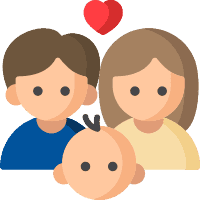Part of helping your child develop–cognitively, linguistically, and more–is setting goals. Knowing how to design goals for your child can help the process along. That means an easier time for both parents and children. This is especially true when it comes to children between the ages of birth-3 years.
Many parents appreciate guidance when it comes to setting goals for kids this young. In part, that’s because goals for a two year old will look significantly different from the goals you’re used to setting for yourself. Goals for children are usually much simpler.
The following tips are designed to give parents guidance and goalposts when it comes to setting goals for your child, and especially for young children. Structuring your child’s goals can help them achieve success–not just between the ages of birth-3 years old, but also for years to come.
Tips to Help You Design Goals for Your Child
Small children have a very different frame of reference than adults do. They don’t have your years of lived experience to draw on, and their cognitive functions are still developing. As a result, it’s useful to take a deliberate and thoughtful approach to setting goals for your child.
It’s okay if you don’t know where to begin! These tips will give you a starting point.
Create Goals Around Already Existing Routines
Many children thrive and rely on steady routines. Your child may very well expect the same thing to occur day in and day out. For example, your child might expect breakfast to occur at the same time every day, even if there are slight variations in what breakfast consists of.
As a result, sometimes the easiest way to design goals for your child is to simply make slight alterations to already existing routines. For example, adding bananas to your child’s cereal during breakfast can get your kiddo into the habit of eating more fruit. (The extension of this wisdom is that completely disrupting your child’s routine in the service of a new goal can be wildly counterproductive.)
Some examples include:
- If your child will soon be enrolling in preschool or daycare, you may want to introduce new routines to help get them ready. For example, you could start by waking them up at the same time every day or helping them get dressed and ready at the same time every morning. These new habits will help prepare them for mornings once they begin going to preschool or daycare.
- You may want to create goals surrounding your child’s motor skills and dexterity. For example, you can start introducing blocks, balls, or other toys into your child’s repertoire. Building habits and goals around playtime can help your kiddo get the practice they need.
Ask Yourself Some Questions When Setting Your Goals
These questions are designed to help you articulate what’s important–and what’s not. After all, the goals you set for your child are a means to an end, not an end in and of themselves. These questions help you articulate what you want your child to accomplish and why.
Ask yourself:
- How long do you want the new behavior to last? Do you want to teach your kiddo a new skill that they’ll use for a few months? Or do you want the skill to last a lifetime? (For example, crawling skills may be observed for a 3-6 month period of time but still worth investing in.)
- How many times do you want your child to perform these activities every week? Something like brushing one’s teeth can be performed 14 or 21 times per week. But taking a bath may be a two-to-three-times-a-week activity.
- For how many weeks do you want to see the change? Do you want your child to adopt this new skill or habit quickly? Or can it be accomplished over a longer period of time?
- How flexible do these new habits and skills need to be? For example, some new habits and behaviors will be very specific to your home, while others will be easily transferred to daycare, school, and more.
Thinking through these questions will help you identify and articulate what you want the end result to look like–and how to design goals to help your child successfully reach that destination.
Consider Your Family When You Design Goals for Your Child
Goals don’t exist in a vacuum, even for small kids. Every goal will have some kind of context. That’s why we encourage parents to consider their entire family when creating and designing goals for their kids.
Consider how this goal–or practicing this goal–will impact other members of your family. You can ask yourself the following questions:
- What do you want your child to improve?
- Is your child’s improvement something that is meaningful to you and your family?
- Will these new skills or habits help your child function better?
The answers to these questions will help you design goals that work both for your child and your family. (Or, at the very least, help prepare your family for possible disruption as you help your child meet their new goals.)
Don’t be Afraid to Call in Help
Helping your child meet new goals and learn new behaviors can be a huge challenge! So you should never hesitate to ask for support and resources from your family and friends. It’s not uncommon at all to need a little help (and that remains true throughout the parenting process).
Your friends and family may have wisdom and experience that can help; in other cases, they may simply be willing to help you with the day-to-day tasks of taking care of your family.
Helping Your Child Develop New Goals
As your child grows, learns, and develops, some of the new goals you may design for them will likely be small; others may be significant and substantial. In either case, remember that achieving goals and building behaviors takes time. Don’t rush the process!
If you need help reaching your child’s goals–or designing them in the first place–you can always reach out to a specialist like a speech language pathologist. If you have concerns about your child’s speech development, for example, you can contact us to schedule an appointment today!


